Viola adunca var. minor (syn. V. conspersa)
Kim’s unedited notes. Illustrations: 9 photographs of Viola adunca minor and 1 comparative diagram

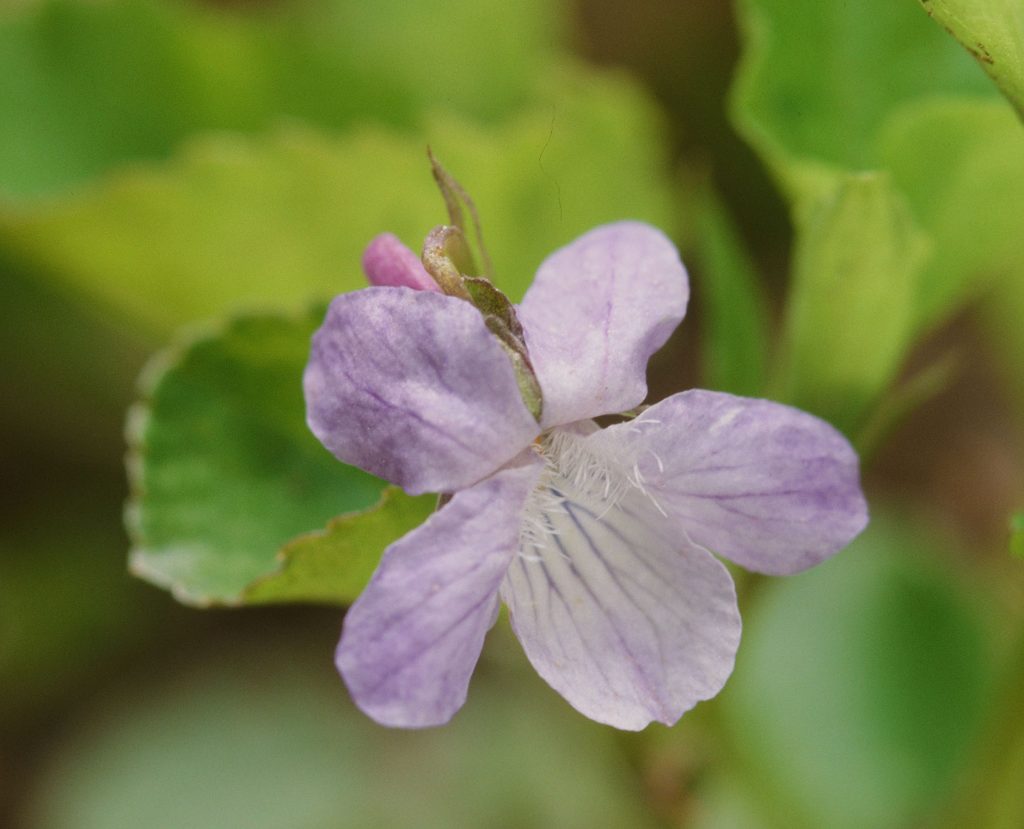
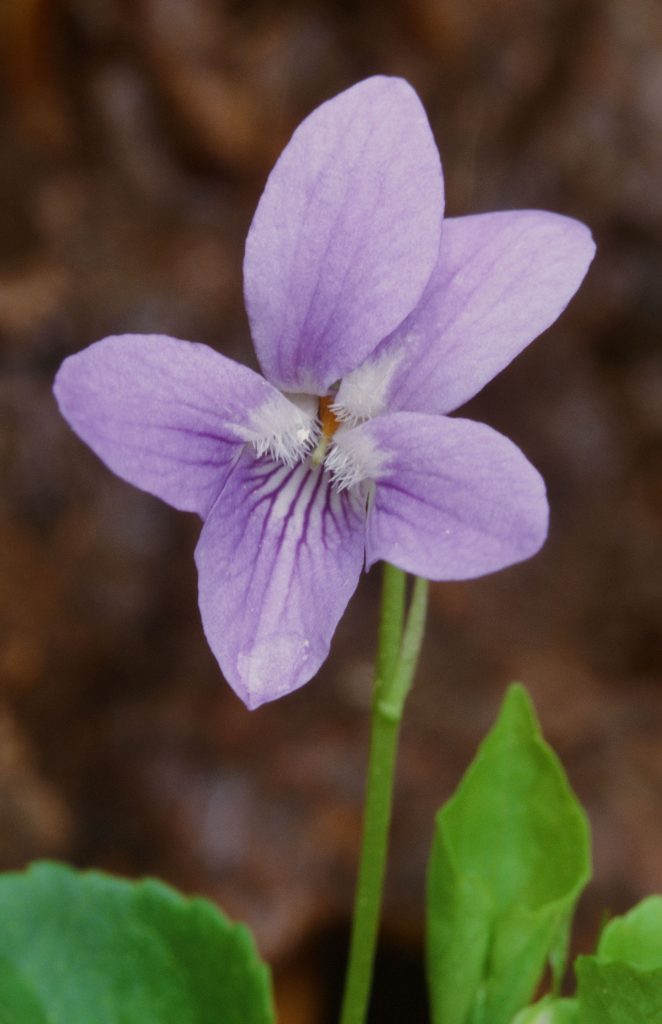
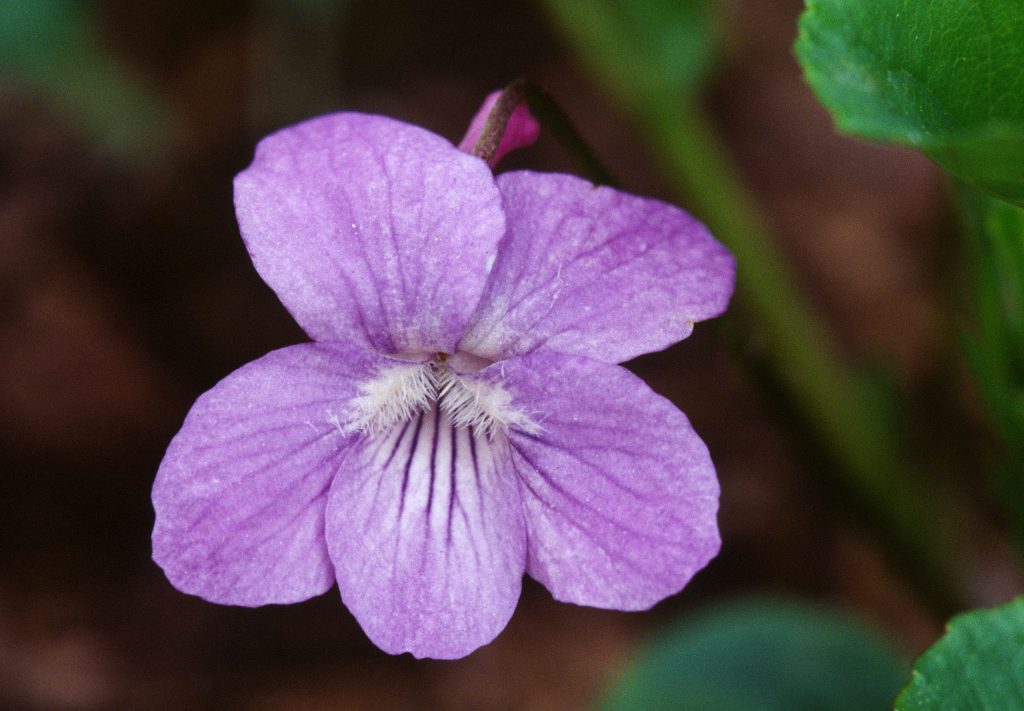
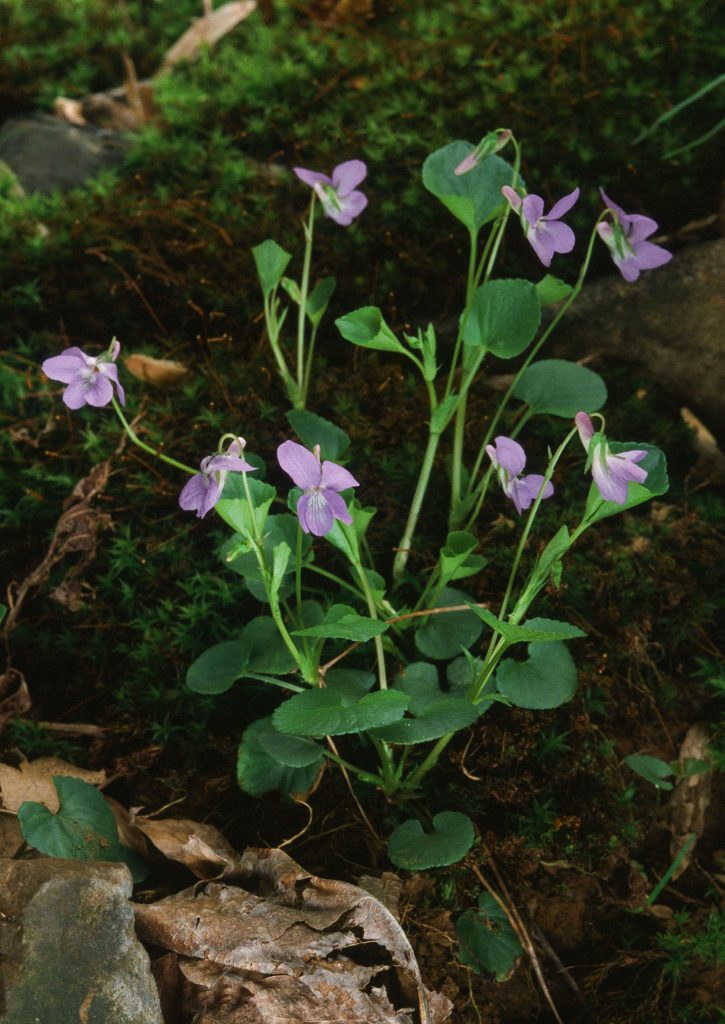
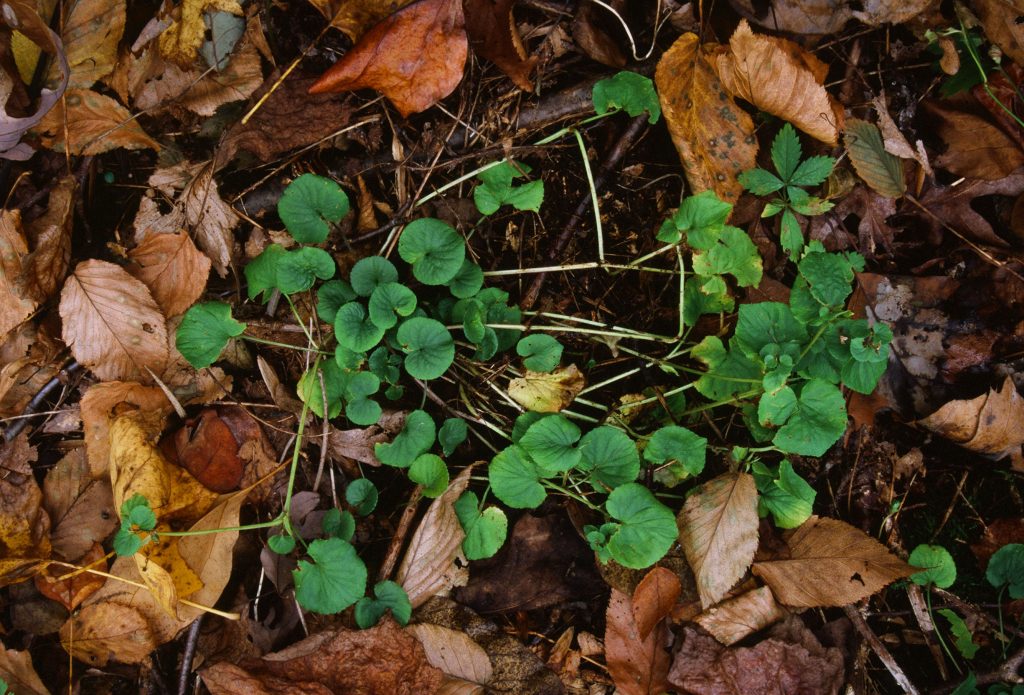
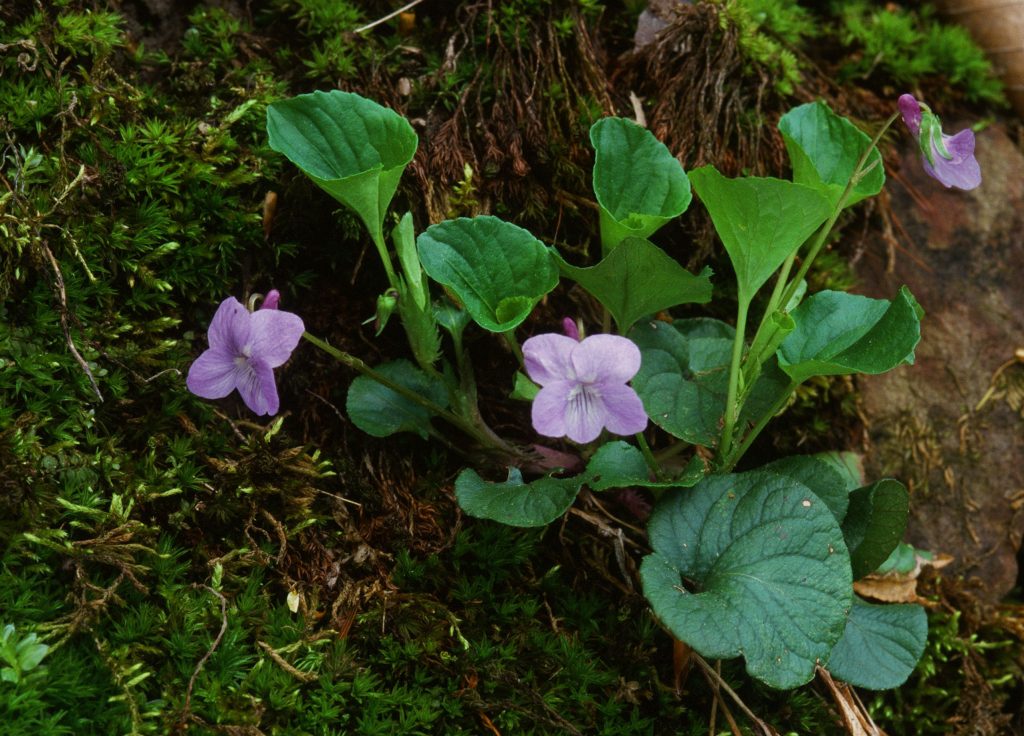


Viola adunca Sm. var. minor ( Hook. ) Fernald
Rhodora 51: 57. 1949
synonym: Viola muhlenbergiana var. minor Hook. Fl. Bor.-Amer. (Hooker) 1: 78. 1830
From the date of publication, V. labradorica name (1818) precedes this, and also precedes V. conspersa, but the date for V. adunca var. adunca is 1817.
Viola conspersa Reichenb.
Plan. Crit. 1: 44, pl. 52, fig. 108, 1823.
Grows on limestone.
Leaf margin pubescence does not seem to be a reliable characteristic to differentiate between adunca (+/-), adunca minor (conspersa VF -, others not recorded) and labradorica (-). Leaf shape especially distal end (tip) and leaf bases seem more reliable.
Viola adunca minor grows on limestone substrate and on sandy/gritty granite, V. conspersa on diabase (high in calcium). Rhoads (Ballard) says that these two species are conspecific but I do not agree. Diabase at Walnut Run. Mike Slater says it also grows on diabase at Nolde and again at another spot near his house. V. labradorica in Newfoundland is growing on limestone. Water from Loveland Pass stream from lake is pH 7 to 7.5, calcium microequivalents/litre is approx. 200. Can’t find any more specific info about the geology here, so far. Growing on limestone Bruce Peninsula, Ontario, Canada. Seen May 24, 09 at Allenstown growing on sandy granitic, definitely acidic soil with Viola sagittata; also in northern Bucks Co. PA on the same soil 5 May, 09 with Mike Slater: State Game Lands 56, which has a moist meadow containing a number of interesting plants, including a good-sized population of Aristolochia serpentaria. Photographed V. Xpalmata, and hirsutula flowers, V. adunca minor, V. sororia, also V. Xsubsinuata?? See other notebook. Not diabase here at this location.
Directions: From Doylestown, take PA Route 611 north. At 1.2 miles north of Ottsville, the road forks; take the left branch to get onto Durham Rd/PA-412. Follow this road for 0.5 miles, then turn left onto Mountain View Dr/PA-563. After 1.2 miles, turn right onto Top Rock Trail. After 0.6 miles, where the road bends to the right, pull into the parking lot on the left. The lot has no sign visible from the road, but once you are in the lot, you will see a sign saying “Welcome, Hunt Safely.” To get directions from Mapquest or other on-line service, use the address 200 Top Rock Trail, Kintnersville, PA.
Viola adunca minor collected near Cavern Lake, near Dorian, Ontario. Pod obovate, green, sepals and auricles separated from seed pod. Three outside auricles longer, toothed at end, glabrous, green + little purple, sepals lanceolate, glabrous, + little purple.
New York State, 24-25 April, 2010: Limestone areas of Glimmerglass State Park, Otsego County and Van Hornsville School Nature Trail, Herkimer County, sites close to each other. Both places were very early in season, not many plants in flower. Glimmerglass S.P. is at the edge of the Onondaga Limestone. Species seen growing there include: Viola sororia, Viola adunca minor, Erythronium americanum, Podophyllum peltatum, Sanguinaria canadensis, Dentaria laciniata, Trillium erectum and Symplocarpus foetidus (Skunk cabbage), American Beech (Fagus grandifolia), Silver Birch, Hickory (Carya) trees.
Van Hornsville School Nature Trail was an area of pure limestone, some like tufa rocks, and large rocks with caves. Species: Viola sororia, Viola adunca minor, V. scabriuscula (eriocarpa/pensylvanica), Viola rotunifolia, Erythronium americanum, Hemlocks (Tsuga) were dominant, American Beech (Fagus ?), Hickory trees, Podophyllum peltatum, Dentaria laciniata, Trillium erectum, Geranium maculatum, Dicentra canadensis and D. cucullaria, Uvularia, Asarum canadensis, Blue Cohosh (Caulophyllum thalictroides).
From the Rock Garden Quarterly, Vol. 66, No. 1, Winter 2008, p.11, in an article by Marilyn H.S. Light ‘Along the Lauriault Trail [Quebec]’:
‘Acer pensylvanicum and Trillium erectum grow in soil derived from gneiss, whereas Acer saccharum and Trillium grandiflorum thrive in carbonate-rich soil atop marble. Furthermore, much of the marble is fractured, permitting good drainage and also wicking of moisture from underground reserves during drought.’
On the Bruce Penninsula, Ontario, Canada [alkaline], as along the Lauriault Trail, Viola canadensis, Viola adunca ssp. minor and Viola pubescens occur frequently in association with Trillium erectum.
Lilium philadelphicum grows on limestone soil [Rock Garden Quarterly, Vol. 66, No. 1, Winter 2008, p. 4] as in the Hiawatha State Forest of the Upper Peninsula of Michigan. At the same site were growing Viola adunca var. minor and Cornus canadensis. The same lilies were growing at Dorion, on our walk in to Cavern Lake, and the same violet was present in many places here. Some of the violet plants were very short but were the same delicate plants that occurred in Ontario, Bruce Peninsula and in Wisconsin. Although short, they did have extended stems, c.f. Viola labradorica that has very short compact stems. Also growing in this region was Viola pallens but in wetter places.
Viola adunca minor coll. Bruce Peninsula:
Seed pod green glabrous, 4.5 mm long. Seeds pale brown, lightly spotted, 1.0-1.2 x 0.6 mm, large colourless elaiosome.
Seeds from 2 pods = 11.
Saw some plants (collected seeds) in Hiawatha State Forest on northern peninsula in Michigan, smaller, more delicate, leaves not rounded as found on V. conspersa at Nolde or Walnut Run or Valley Forge. This area is the western end of the calcium basin of which the Bruce Peninsula in northern Ontario is the eastern part separated [check that this is right] by Lake Huron. There were also many plants on the trail to Cavern Lake, Dorion, western Ontario, Canada, some very small and short, getting down almost to the size of V. labradorica from Newfoundland. Collected seeds there too. All these plants were more delicate, i.e. had thinner stems, smaller, thinner leaves, generally looked finer than PA locals that I have been calling V. conspersa. At the Cavern Lake site there were the same Lilium philadelphicum that was growing in the Hiawatha State Forest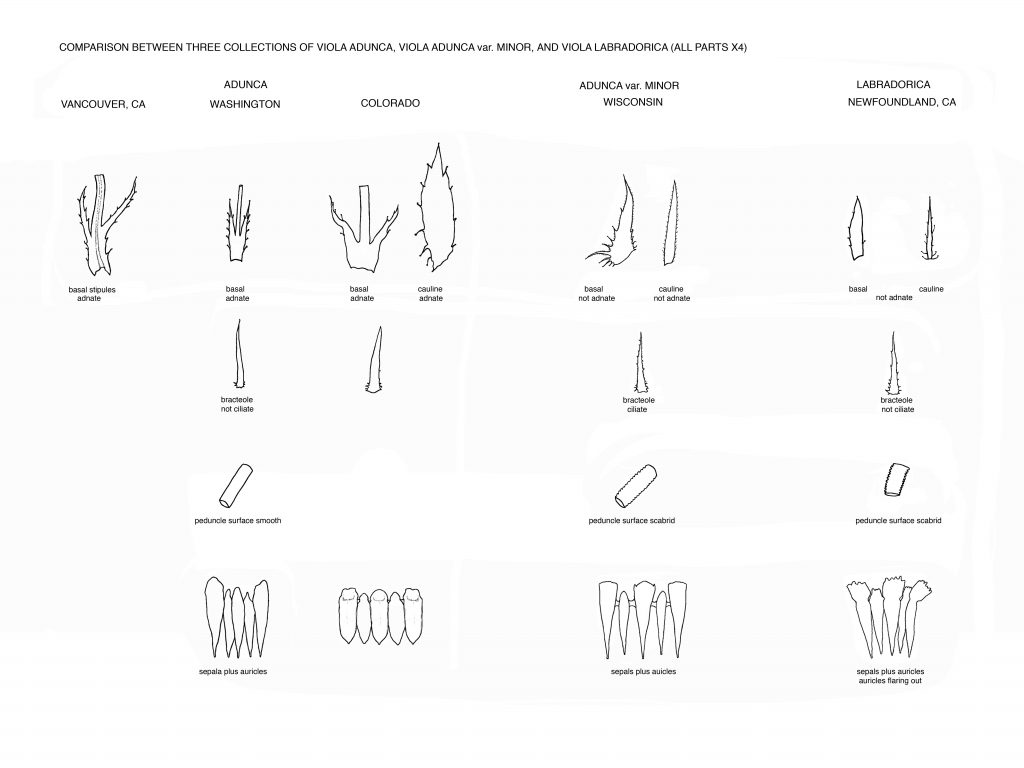
Subtle differences in soil preferences:
V. adunca minor on pure limestone;
V. canadensis and V. pubescens var. scabriuscula on alkaline soils but with more protection, deeper soils and some poplar and maple leaf litter;
V. sororia on limestone substrate with cedar and other conifer needles modifying the soil, also wetter places. There is some overlap, e.g. at Dorion, Cavern Lake where V. pallens and V. adunca minor grow close together but the former in slightly wetter places.
Rock Garden Quarterly, Vol. 66, No. 1, Winter 2008, p. 5, ‘The burnt Lands Alvar: Horticultural Hot Spot’ by Brian Carson:
In Ottawa’s west end, there is a large, flat, open area of scrubland known locally as the Burnt Lands, that looks like a barren wasteland. This harsh habitat comes alive in early spring… [the plants] have little soil… Airy cushions of Arenaria stricta and vibrant Viola adunca [var. minor] billow out of the ancient limestone crevices. … shallow soil over flat limestone.’ Other plants mentioned in this situation are Polygala paucifolia, Lilium philadelphicum, Saxifraga virginiensis, Ceanothus herbaceus, Petasites frigidus, Cypripedium parviflorum, Cyp. reginae, Cyp. arietinum, Calystegia spithamaea, Rosa glauca, Campanula rotundifolia, Penstemon hirsutus, Hieracium caespitosum, Agalinis tenuifolia, Gentianopsis crinita (fringed gentian). [Interesting that there is no Viola canadensis and no V. pubescens in this area. Too exposed? Soil too shallow?
The three differences I have worked out between V. conspersa and V. adunca minor are:
- Stipules of former are wide lanceolate with very feathered margins, latter narrow lanceolate and either entire or few short teeth/divisions on margin.
- Rhizome horizontal for former cf. vertical for latter.
- different leaf shapes.
- V. conspersa is a more robust plant, V. adunca minor is more delicate
- Slugs devour V. labradorica, are attracted from all around, but do not touch V. conspersa growing next to it, nor V. appalchiensis. Flower buds, leaves, and the whole plant, each year!
Gerd Knoche, 28 Oct, 08: When I compared Viola adunca and conspersa I noticed a further difference between them. The first one has long petioles along the whole shoots while the second one has only long ones at the lower part. The stipules are similar, maybe those from labradorica are a little bit narrower. I hope I can have a look at the flowers next spring.
2006: Viola labradorica from Newfoundland grows on limestone and is distinct from Viola conspersa which grows on diabase (pH neutral). Look at stipules of V. adunca ssp. minor from Wisconsin. V. labradorica has entire stipules or only one or two small teeth, cf. conspersa from Walnut Run that has feathered edge to stipules.
Go and look again at the ones in Valley Forge N.P. or look at notes and drawings for stipule detail. Viola labradorica is NOT a synonym for V. conspersa.
Viola adunca minor grows on limestone and is distinct from V. labradorica (Newfoundland). The leaf tip (distal end?) of adunca is rounded but V. labradorica is sharp. Also V. labradorica does not produce long stems in summer that fall down to a horizontal position in summer, as do V. conspersa and V. adunca var. minor. V. adunca var. minor from Wisconsin is distinct from V. labradorica from Newfoundland that does not produce long stems in summer that fall down to a horizontal position in summer.
Viola adunca minor ex Wisconsin: spring vertical stems, later in late summer to autumn there will be prostrate on the soil, while a fresh growth of stems arise from the centre of the plant and these late season leaves will be persistent while the older decumbent stems die off in winter. Leaf bases cordate (cf. western adunca that has truncate to attenuate leaf bases). Cilia on margins of basal leaf stipules as well as many short to long fimbriae, also same for Walnut Run specimens (cf. V. labradorica with few very short marginal teeth or fimbriae), basal leaves only adnate for up to one quarter of their length. On cauline leaves, stipules not adnate and are narrower, narrow-lanceolate without fimbriae, petiole narrowly winged for whole of length, leaf glabrous, petiole glabrous. Peduncle scabrid above bracteoles. On cleistogenes, auricles truncate to slightly toothed, not flaring outwards out and not appressed to peduncle, uneven in size and length (cf. V. labradorica the flared and more crenations on end of auricle). Bracteoles ex Wisconsin with some short cilia around margins, cf. V. labradorica no cilia.
Notes for V. conspersa from Valley Forge, my drawing p. B 27, growing on diabase seam:
(syn V. conspersa Rchb., V. adunca var. minor (Hook.) Fernald)—see Vol. 2, p. 1379.
Caulescent perennial. Rhizome ascending, thin; stems vertical glabrous, green. No basal leaves. Leaves rounded to reniform, tip rounded, cordate base sometimes overlapping, new leaves folded in at basal lobes, 3.8 x 3.8 cm; upper surface has very short hairs on veins, lamina towards outer edge of leaf and on basal lobes; lower surface glabrous, hairs on margin in sinus only. Petioles green, glabrous. Stipules lanceolate with few large irregularly spaced serrations, margin with glandular-tipped cilia, highest cauline stipules are largest, glabrous, green, free, 1.8 cm long x 0.6 cm wide. Peduncles erect, glabrous, long equaling the top of the leaves, length equal to lowest petiole, bracts in middle thin, tapering, with marginal cilia at base, 6 mm. Flowers pale blue-violet, 1.5-1.8 cm long x 1.6-2.1 wide cm, axillary, RHS# 88C, 88C-D, white throat or eye on all petals, purple guidelines on spurred petal; sepals plus auricles green, glabrous, 0.8 cm; sepals long-triangular, gradually tapered, hyaline margins, 4-8 mm; auricles uneven in size, wider than sepal, not appressed (Ballard says they are) but close to pedicel, glabrous, longest is less than 0.1 cm; hairs on lateral petals dense, thin, tapered to end; spur light purple, saccate, 5-6 mm long; ovary green, glabrous; style and stigma colourless; style long, thin, stigmatic head small, rounded, tapering into beak pointing upwards, with relatively large stigmatic opening, stigmatic head pubescent at back, ovary, style and stigma 4-4.5 cm high. Seed capsule colour green, mature seed colour mid-brown. No perfume. 2N=20. Area of damp seep down the hill. April 17,98 – May. Photo.
Adunca minor herbarium specimen from Vail has cilia on peduncles, stems, petioles, but not on stipules or bracteoles. Plants from Cache County, Utah have no cilia on bracteoles or stipules. Are these Viola adunca minor??
Viola adunca var. minor or V. labradorica) at Loveland Pass, 11,000 ft. (above the treeline/timberline) around the top of the lake, July 13,94. Loveland Pass is on the Continental Divide, on Precambrian granite [but the pH of the water coming out of the lake is 7.5 see somewhere else]. Pass Lake just south of the pass occupies another glacial cirque. Huge talus cones form where rock loosened from the cliffs by freezing and thawing tumbles down ravines toward the lake. Perennial, caulescent but not always obvious at flowering, height 5 cm. Rhizome dark brown, vertical branching underground, branch rootstock producing new smaller (younger) plants. Crown producing 3 separate spreading branches, branches, ascending or vertical, very short nodes, all less than 1 cm (the longest one at the base), most too close together to measure, stems green. Leaves ovate to wide-ovate, folded down the mid-vein, typical of V. adunca, tip rounded to almost acute, base truncate, glabrous, 1.8-2.5 cm long x 1.6 cm wide, no purple coloration. Stipules slightly adnate at base, green, margins with fimbriae, 7 mm. Peduncles no purple, glabrous, to 5.5 cm, most shorter; bracts in middle, green, flaring, with few glandular-tipped fimbriae towards base. Flowers axillary, above or equal to top of leaves, RHS 88B-C, 1.5 x 1.5 cm, sepals plus auricles entire or toothed at end, truncate or acute, not adpressed, 0.5 cm; lateral petals with long, thin, dense hairs; spur purple, some slightly hooked at tip, 87 B-C, 4-6 mm; ovary pale green, style and stigma colourless except for a thin purple line down front (abaxial side?) of style at base, stigmatic head rounded, tapered into upturned beak with large stigmatic opening hole, hairs on back and top of stigma. Ovary, style and stigma 0.4 cm high . No perfume. Full sun, wet meadow, in moss around the lake and drier slopes uphill, in area of permafrost.
Viola adunca minor coll. Bruce Peninsula:
Seed pod green glabrous, 4.5 mm long. Seeds pale brown, lightly spotted, 1.0-1.2 x 0.6 mm, large colourless elaiosome.
Seeds from 2 pods = 11.
Saw some plants (collected seeds) in Hiawatha State Forest on northern peninsula in Michigan, smaller, more delicate, leaves not rounded as found on V. conspersa at Nolde or Walnut Run or Valley Forge. This area is the western end of the calcium basin of which the Bruce Peninsula in northern Ontario is the eastern part separated [check that this is right] by Lake Huron. There were also many plants on the trail to Cavern Lake, Dorion, western Ontario, Canada, some very small and short, getting down almost to the size of V. labradorica from Newfoundland. Collected seeds there too. All these plants were more delicate, i.e. had thinner stems, smaller, thinner leaves, generally looked finer than PA locals that I have been calling V. conspersa. At the Cavern Lake site there were the same Lilium philadelphicum that was growing in the Hiawatha State Forest.
From e-mail to Thomas Marcussen: Harvey Ballard has placed Vv. adunca minor and conspersa in synonomy with V. labradorica. I don’t agree with this. I can accept that V. adunca var. minor is the same as V. labradorica, but I think that conspersa is distinct. Gleason & Cronquist treat V. conspersa as a distinct species, with V. labradorica synonymous with V. adunca var. minor. Bill Weber (Professor Emeritus from University of Colorado) once told me that V. adunca minor was diploid, and the lowland V. adunca was tetraploid. Unfortunately he has now, in his mid 80’s, rather lost touch with reality and can no longer be a useful source of information. A few years ago Bill Weber told me that Vv. labradorica and adunca ssp. bellidifolia were synonymous, but in one of his earlier publications, he recognised ssp. bellidifolia as a small subalpine race of V. adunca. ???
Gleeson & Cronquist: ‘V. adunca var. minor (Hook.) Fern., more boreal or in our range, more alpine is essentially glabrous. (V. labradorica).’ This does not agree with my observations of V. adunca var. minor on Bruce Peninsula, or V. labradorica from Newfoundland. Note that I should read Harvey Ballard’s work on the pubescence of these species as mentioned in his Violets of Michigan. Reference is Ballard, H.E., Jr. 1992. Systematics of Viola Section Viola in North America north of Mexico. M.S. Thesis, Central Michigan University, Mount Pleasant. 255 pp. [don’t seem to be able to get this reference!!].
2n=20,40 [as mentioned in Gleeson & Cronquist, who list V. labradorica in synonomy at the end of the description of V. adunca Smith var. minor (Hook.) Fern, and describes it as more boreal, or in our range more alpine, and essentially glabrous but this does not agree with the plants on Bruce Peninsula nor V. labradorica from Newfoundland, both have hairs on upper leaf surface].
Gleeson & Cronquist list V. adunca (with var. minor and V. labradorica in synonymy) separately from V. conspersa. They differentiate the two in the key:
- adunca: stipules lance-linear, bristly toothed less than half their length, leaves sub-truncate to sub-cordate at base. [specimen from Keystone, Colorado Rocky Mountains, very pubescent, not one next to Jewel Lake, has teeth or glandular hairs evenly distributed along the margin of the lance-linear stipule].
- conspersa: stipules broadly lanceolate, bristly toothed usually over half their length, leaves with +/- strong cordate base.
Gershoy (1934: Studies in North American violets III. Chromosome numbers and species characters. Vermont Agricultural Experiment Station, Bulletin 367: 1-91) showed that the hybrids V. conspersa x rostrata and V. rostrata x striata were fertile.
Mike Slater’s Blog http://paplantings.blogspot.com/
TUESDAY, AUGUST 21, 2007
Viola conspersa (Dog Violet) and related “Stemmed” blue violas from Eastern North America
Our friend Kim Blaxland who is especially interested in Viola species e-mailed me today to ask me about Viola conspersa plants that we have seen. It seems there is some question whether this is just an upright form of another species and should be lumped with Viola labradorica*/V. adunca v. minor.
Viola conspersa is a relatively upright plant with light blue flowers and leaves scattered up the stem. While the other species have their stems prostrate on the ground.
She asked especially about what kind of rocks and what the soil pH would be. I think I usually have seen V. conspersa on soil derived from diabase (an intrusive igneous rock which usually give rise to circumneutral soils) here in Berks County, PA The pictures of Viola conspersa here are mine. The first two are from PA State Gamelands #52 (north of Churchtown, Lancaster Co. and south of Maple Grove in Berks Co.) They are growing among and in crevices of diabase boulders along Black Creek. (Kim just e-mailed me and said of the first picture “Lovely photo of V. conspersa! Shows the spurs well, also the purple leaves persistent from the previous year compared with the color of the new spring leaves .” The last three pictures are from Middle Creek WMA and are in the wet meadow on sandstone derived soils that I though were acid.
If anyone can tell us about locations for Viola conspersa and what kind of soil they are growing in and the parent rock the soil derived from that information would be appreciated.
Kim wrote: Harvey Ballard, violet expert from Athens Ohio, who wrote the Violaceae treatment in the Flora of Pennsylvania has said that Viola labradorica and Viola adunca v. minor are conspecific and that they merge into Viola conspersa . By Viola labradorica I do not mean the purple-leafed violet of cultivation that is actually Viola riviniana purpurea. I mean the real Viola labradorica as it occurs in Newfoundland, Labrador, Greenland, and high mountains on the Gaspe Peninsula and northern Maine.
I am studying these three species in the NE to try to justify continuing to recognize Viola conspersa as a distinct species.
The stems of V. conspersa do lie down horizontally after flowering, and in autumn the plant will produce new short upright stems in the center from the rhizome.
The two differences I have worked out between V. conspersa and V. adunca v. minor are: 1. Stipules of former are wide lanceolate with very feathered margins, latter narrow lanceolate and either entire or few short teeth/divisions on margin. 2. Rhizome horizontal for former cf. vertical for latter. V. conspersa does not grow at Shenk’s Ferry does it? I’ve never seen it there. It would be very interesting to test the soil pH at some of these places. Maybe I need to buy a pH meter.
It was interesting writing the descriptions for you, comparing V. appalachiensis with the other three species made me realize that the only differences between them is that V. appalachiensis has rounder leaves, horizontal stems and finer longer peduncles. The three species, V. adunca minor, V. labradorica and V. conspersa all have vertical stems, its just that those of V. labradorica are much shorter. Viola adunca v. minor and Viola labradorica both occur on limestone. Viola labradorica reaches a maximum height of only three inches. I saw it growing in shallow depressions in the flat coastal limestone peninsulas at the NW tip of Newfoundland, sheltering for protection from the severe winds. Under these extreme weather conditions it is not surprising that it is so small. Viola adunca v. minor grows taller, to 5-6 inches, in light woods, for example on the Bruce Peninsula, NW of Toronto in Canada. All the morphological characters of these two species are the same except for the overall size. Several stems and a few basal leaves arise vertically from the top of the rhizome. Cauline leaves are evenly distributed up the stems. Leaves are reniform to cordate, stipules entire or with only a few teeth, flowers pale mauve on peduncles from the axils of the leaves on the stem. Fine hairs are on the inside of the lateral petals. The head of the style is bent into a hook with fine hairs on the side near the stigmatic opening. The spur at the back of the lowest petal is tapered, 4-5 mm long. Viola conspersa is usually about the same height as Viola adunca v. minor, flowers are of a similar color but usually slightly larger. The leaves have slightly more cordate bases, and the stipules have more feathered margins, but there do not seem to be enough obvious major differences in morphology to separate these species. However, I have only seen Viola conspersa growing on diabase and sandstone.
Another interesting stemmed violet is Viola appalachiensis that occurs on the Allegheny plateau in western Pennsylvania, also growing in alkaline soils. It grows as a mat forming ground cover because the stems creep horizontally on the ground surface, though usually not rooting from the nodes. The leaves are small and round to reniform. Light mauve flowers are borne from the leaf axils but well above the leaves on tall delicately thin peduncles. The petal spur is tapered and about as long as the three species mentioned above
Two additional notes:
1) V. conspersa x V. striata hybrids thrive where soil has been limed (Dick Lighty pers. comm.) and a note about Diabase soils from NC.
2) Soils derived from the diabase rock (Iredell on uplands and Wilkes sandy loam at the base of the slopes) are quite different from typical Piedmont soils that are acidic or sour soils with a low pH. Soils derived from diabase rocks are basic, or sweet, with a high pH. Sweet soil is ideal for certain kinds of plants typically found in other regions of the United States, particularly in the prairies of the Midwest.